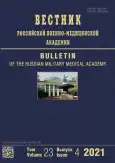Application of remote mobile monitoring using the “ECG-DONGLE” electrocardiograph in patients with chronic heart failure
- Authors: Frolov D.S.1, Salukhov V.V.1, Izilyaeva E.A.1, Stepanenko I.A.1, Sveklina T.S.1
-
Affiliations:
- Military Medical Academy named after S.M. Kirov of the Ministry of Defense of the Russian Federation
- Issue: Vol 23, No 4 (2021)
- Pages: 71-78
- Section: Clinical trials
- URL: https://journals.rcsi.science/1682-7392/article/view/63710
- DOI: https://doi.org/10.17816/brmma63710
- ID: 63710
Cite item
Abstract
The urgency of remote monitoring of the patient’s condition, early diagnosis, and timely detection of precursors of deterioration during chronic heart failure using the telemonitoring systems is substantiated. We examined 10 patients (4 women and 6 men aged 64 ± 12 years) suffering from a heart failure with a high risk of adverse outcomes, the mean left ventricular ejection fraction was 34.4% (32.1%; 37.6%), as well as 10 healthy men (control group, mean age 21 ± 3 years). Each participant was provided with a home monitoring and communication kit (tablet computer with the Internet access, mobile ECG-Dongle electrocardiograph). Also, an individual plan for the treatment of heart failure and associated diseases was developed for the participants. The resulting image using a mobile electrocardiograph “ECG-Dongle” fully corresponds to the data of a stationary 12-lead electrocardiograph. The use of monitoring the electrocardiogram using a remote access solves the problem of timely personalized identification of predictors of deterioration in the patient’s circulatory system, while helping to identify a possible cause of destabilization of the course of heart failure, which contributes to the timely correction of the therapy in the early stages. Mobile computing technologies for a remote access, data transfer, and information processing are now being introduced in telemonitoring systems. The remote rehabilitation monitoring system based on the mobile communication could be used as an auxiliary model of outpatient care in the management of patients suffering from a chronic heart failure. We believe that by using such systems, work with the patient could be more effective, namely, self-control of behavior and improved quality of life, which in turn, could lead to a decrease in the rate of the repeated hospitalizations and mortality of the patients suffering from a chronic heart failure.
Full Text
##article.viewOnOriginalSite##About the authors
Dmitriy S. Frolov
Military Medical Academy named after S.M. Kirov of the Ministry of Defense of the Russian Federation
Author for correspondence.
Email: froloff_82@mail.ru
ORCID iD: 0000-0002-4625-2671
SPIN-code: 4089-0078
Scopus Author ID: 48761185800
candidate of medical sciences
Russian Federation, Saint PetersburgVladimir V. Salukhov
Military Medical Academy named after S.M. Kirov of the Ministry of Defense of the Russian Federation
Email: vlasaluk@yandex.ru
ORCID iD: 0000-0003-1851-0941
SPIN-code: 4531-6011
Scopus Author ID: 55804184100
doctor of medical sciences, доцент
Russian Federation, Saint PetersburgElizaveta A. Izilyaeva
Military Medical Academy named after S.M. Kirov of the Ministry of Defense of the Russian Federation
Email: izi_li55@bk.ru
ORCID iD: 0000-0003-2756-8686
SPIN-code: 1311-5535
Russian Federation, Saint Petersburg
Ivan A. Stepanenko
Military Medical Academy named after S.M. Kirov of the Ministry of Defense of the Russian Federation
Email: icetp@rambler.ru
ORCID iD: 0000-0001-6436-5656
SPIN-code: 9174-8800
ResearcherId: Q-4709-2017
candidate of medical sciences
Russian Federation, Saint PetersburgTatyana S. Sveklina
Military Medical Academy named after S.M. Kirov of the Ministry of Defense of the Russian Federation
Email: sveklina@rambler.ru
ORCID iD: 0000-0001-9546-7049
SPIN-code: 3561-6503
Scopus Author ID: 3700129990
candidate of medical sciences
Russian Federation, Saint PetersburgReferences
- Vladzimirsky AV, Lebedev GS. Telemedicine. Moscow: GEOTAR-Media; 2018. 576 c. (In Russ.).
- SUPPORT-HF 2 Investigators and Committees. Home monitoring with IT-supported specialist management versus home monitoring alone in patients with heart failure: Design and baseline results of the SUPPORT-HF 2 randomized trial. American Heart Journal. 2019;1:55–64.
- Kryukov EV, Zaretsky AP, Kirillova KK., et al. Analysis of current trends in the field of electrophysiological studies of persistent atrial fibrillation. Bulletin of New Medical Technologies. 2017;24(4):89–104. (In Russ.). doi: 10.12737/article_5a38f5d0ee1814.76985721
- Gromyko GA, Kryukov EV. Sudden cardiac death in patients with postinfarction cardiosclerosis and an implanted cardioverter-defibrillator – is further risk stratification necessary? Bulletin of the Russian Military Medical Academy. 2017;3(59):228–231. (In Russ).
- Oynotkinova OSh, Ermakov NA, Shklovsky BL, еt al. The role of technogenic factors in the development of cardiovascular diseases. Kremlin Medicine Clinical Bulletin. 2019;4:37–44. doi: 10.26269/5cvy-tz32
- Flash drive will perform an ECG. Modern Cardiology. 2017;2:3.
Supplementary files

















